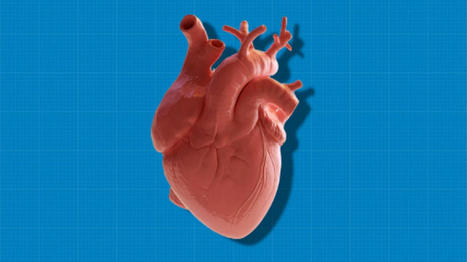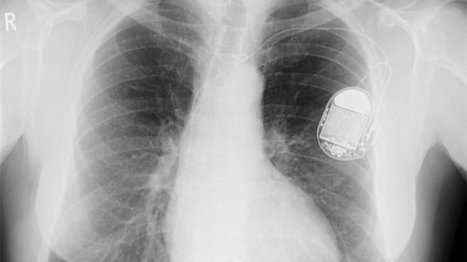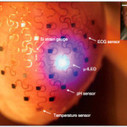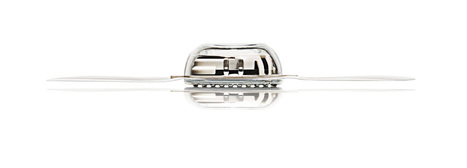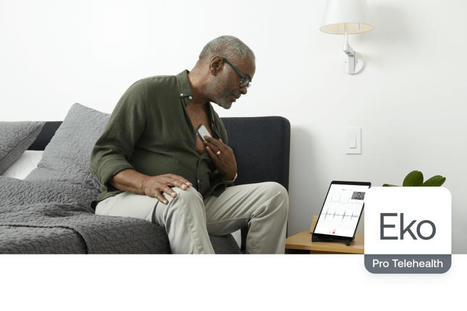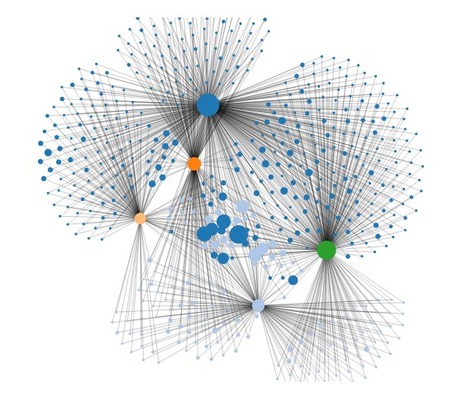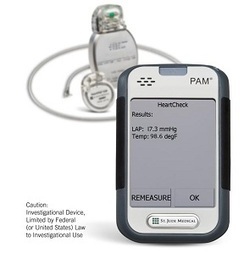 Your new post is loading...
 Your new post is loading...

|
Scooped by
nrip
|
A team of researchers has developed the first human "mini-hearts" in the lab to have clearly beating chambers. The miniature organs, or organoids, are no bigger than sesame seeds and were generated by self-assembly using pluripotent stem cells, according to Science Magazine. The organoids mimic the functioning heart of a 25-day-old human embryo, and they may help humans solve the heart's many mysteries. Our capability to model the complexity of the human heart in vitro is still limited, consequently limiting our knowledge of how heart diseases develop. Congenital heart defects, for example, are the most common birth condition in humans, affecting around 1 percent of all live births. This alone demonstrates the need to create more precise organ-like platforms, which is where the researchers come in, with their newly devised method which was described in a study published in the journal Cell. The researchers engineered human pluripotent stem cells, which can divide into any kind of tissue, into multiple forms of cardiac cells to create heart organoids whose cells self-organize like those in an embryo. The aim was to create three tissue layers that make up a heart chamber's walls, which are one of the first parts of the heart to form. The organoids, which are around 2 mm in diameter and have survived more than 3 months in the lab so far, become structurally equal to the heart of a 25-year-old embryo in a week. They only have one chamber and the main types of cells at this point of development. Moreover, the heart's clearly defined chamber beats 60 to 100 times a minute, much like the heart of an embryo at the same age. read the entire story at https://interestingengineering.com/lab-grown-mini-heart-beats-like-a-25-day-old-human-embryos-heart

|
Scooped by
nrip
|
- The world's largest technology companies have all hired well-known cardiologists.
- Heart disease and high blood pressure affect a large number of people, are well-understood, and there's evidence that consumer products can help.
Big Silicon Valley companies have often competed for talent with specialized skills, like expertise in artificial intelligence or trendy new programming languages. Now they're competing for heart doctors. Apple, Alphabet, and Amazon have all hired well-known cardiologists. This might just be a coincidence. Cardiologists tend to be well educated and hard working, and big tech companies have a track record of recruiting such people. In recent years, all of these companies have started to invest in products and devices that are targeted to millions of people who could benefit by tracking their heart health. Apple's smartwatch now includes an electrocardiogram, which can detect heart rhythm irregularities. Verily's study watch, which is designed for clinical trial research, also tracks heart rate and heart rhythm, and it's doing a lot of work in chronic disease management. So the more likely explanation is that tech companies are interested in health care, and they have all come to the conclusion that cardiology should be an early (if not initial) target. Here's why. It's a huge potential market Heart disease is the No. 1 killer in the world, and strokes are among the leading causes of death. And that's not all that cardiologists treat. "Our scope covers other common disease such as high blood pressure, which impacts about a third of people in the U.S. — 75 million Americans — as well as lipid and cholesterol disorders," said Dr. Mo Elshazly, a cardiologist and assistant professor of medicine at Weill Cornell Medicine. Many cardiologists are also experts in nutrition and exercise science, which impacts a huge number of people who are committed to staying healthy. That's useful for the teams within the largest tech companies that are more focused on wellness and fitness applications, rather than on health and medical. Alphabet has Google Fit. Apple has a fitness group for its Apple Watch. And Amazon is looking at health and wellness applications for its Alexa voice assistant. It's well-studied Cardiology is among the most-studied fields in medicine, meaning there's already a lot of evidence to understand the root causes of heart disease, as well as how to prevent it. That's attractive for tech companies, which tend to base their development decisions on data. Their consumer products are already making a difference Let's take Apple, as an example. The company launched its first Apple Watch model with a heart rate sensor, never expecting that people would use it to discover they were pregnant, at risk for a heart attack or experiencing a dangerous irregular heart rhythm. But as people began sharing examples of how the Apple Watch saved their life, the company started to invest heavily in the science and technology to drive more of these stories. A lot of that work culminated in the first-ever clearance for a heart rhythm sensor called an ECG for Apple Watch earlier in the summer. read more at https://www.cnbc.com/2018/10/17/what-every-tech-company-needs-a-cardiologist.html

|
Scooped by
nrip
|
Cardiologists in Los Angeles have developed a gene-therapy technique that allows them to transform working heart-muscle cells into cells that regulate a pigs’ heartbeat. This procedure, described today in the Science Translational Medicine, restored normal heart rates for two weeks in pigs that usually rely on mechanical pacemakers. The experiment, researchers say, could lead to lifesaving therapies for people who suffer infections following the implantation of a mechanical pacemaker.
"We have been able for the first time to create a biological pacemaker using minimally invasive methods and to show that the new pacemaker suffices to support the demands of daily life," Eduardo Marbán, a cardiologist at the Cedars-Sinai Heart Institute and lead author of the study, told the press yesterday. The approach is practical, added Eugenio Cingolani, a cardiogeneticist also at Cedars-Sinai and a co-author of the study, because "no open-heart surgery is required to inject this gene."
In the study, researchers injected a gene called Tbx18 into the pigs’ hearts. This gene, which is also found in humans, reprogrammed a small number of heart-muscle cells into cells that emit electrical impulses and drive the beating of the heart. The area in which this change occurred — about the size of a peppercorn — doesn't normally initiate heartbeats.
"We were able to get the biological pacemaker to turn on within 48 hours," Marbán said. To get the gene to the heart, the researchers sent a modified virus into the right ventricle through a catheter. The viral vector isn’t harmful, the researchers said, because the virus they employed was engineered to be "replication deficient" — meaning that it will not reproduce and spread beyond the heart.
Overall, the results of the study demonstrate that the pigs who received the gene therapy experienced an increase in heart rate that allowed them to be much less dependent on backup pacemakers. In contrast, the backup pacemakers were responsible for more than 40 percent of the beats in pigs who didn’t receive the gene therapy, but still underwent surgery.
more at http://www.theverge.com/2014/7/16/5906563/biological-pacemakers-gene-therapy-heart-muscle-cells

|
Scooped by
nrip
|
The buzz about 3D printing can at times give the impression that the technology is a panacea that makes all manufacturing cheaper. The truth is 3D printing has one very specific use case: It makes prototypes and custom, one-of-a-kind items cheaper and faster to make.
Medicine would seem like a prime beneficiary of this technology, potentially using 3D printing to provide patients with custom-made implants and stents. Yet, to date, medical researchers have focused on the most ambitious goals for the technology, such as replacement organs printed from a patient’s own stem cells, which need years of development before they reach average patients.
Recently, a somewhat more modest medical device — and one that could find its way relatively quickly into treatment protocols — was created using 3D printing. Researchers Igor Efimov from Washington University in St. Louis and John Rogers from University of Illinois at Urbana-Champaign used MRI and CT scans of rabbit and human hearts to 3D-print custom-fitting flexible mesh sacs that fit each heart perfectly and stayed in place as it beat.
“Each heart is a different shape, and current devices are one-size-fits-all and don’t at all conform to the geometry of a patient’s heart,” said Efimov.
Inside its fabric, the mesh can also hold sensors that monitor for signs of trouble and deliver electrical pulses, if needed. The sensors are embedded in the fabric using technology similar to what Google has said it will use in sugar-monitoring contact lenses, only more nuanced.
Doctors can position the sensors or electrodes more precisely using the wrap than by attaching them directly to the heart with sutures or adhesives, Efimov and Rogers state in a recent paper in Nature Communications. They demonstrate in the paper that sensors attached to the mesh (or multifunctional integumentary membrane) accurately measure temperature, mechanical strain and pH, and could deliver pulses of electricity.
Depending on the sensors used, the heart wrap could improve treatments for a range of disorders; it could also be used to deliver medication directly to where its needed. But the device was conceptualized specifically to treat ventricle deformities and arrhythmias. The arrhythmia atrial fibrillation affects about 4 million Americans; patients often undergo a surgery that destroys the heart’s own drummer, the atrioventricular node, and subsequently receive a pacemaker.

|
Scooped by
nrip
|
New research indicates a wireless device could do a better job than the Holter monitor, the standard of care for mobile heart rhythm monitoring over the past half-century.
The Scripps Translational Science Institute compared the Holter monitor with the ZIO Patch, an FDA-cleared, non-invasive, water-resistant device worn on the chest for up to two weeks. STSI, based in San Diego, compared electrocardiograph data from 146 Scripps Green Hospital ambulatory care patients who were fitted with both the ZIO Patch and a Holter monitor.
In all, researchers said, the ZIO Patch, developed by San Francisco-based iRhythm, identified 96 arrhythmia events, while the Holter monitor detected 61.
“This is the first large prospective validation that this new technology superseded the device invented by Norman Holter in 1949,” said Eric Topol, MD, chief academic officer at Scripps Health and STSI's director.
Topol, a cardiologist and lead author of the study, continued in a prepared statement that over the course of tracking every heartbeat for two weeks “the ZIO Service proved to be significantly more sensitive” than the Holter, which consists of a cellphone-sized recorder usually worn about the waist and five to seven lead wires attached to the chest and can only be worn for 24 hours at a time.
“For millions of people who present each year with suspected arrhythmia, this may prove to be the new standard for capturing the culprit heart rhythm electrical disturbance, most commonly atrial fibrillation which carries a significant risk of stroke,” Topol added.
|

|
Scooped by
nrip
|
Eko, a cardiopulmonary digital health company, today announced the peer-reviewed publication of a clinical study that found that the Eko artificial intelligence (AI) algorithm for detecting heart murmurs is accurate and reliable, with comparable performance to that of an expert cardiologist. These findings suggest utility of the FDA-cleared Eko AI algorithm as a front line clinical tool to aid clinicians in screening for cardiac murmurs that may be caused by valvular heart disease. For moderate-to-severe aortic stenosis, the algorithm was found to have sensitivity of 93.2% and specificity of 86.0%. The algorithm significantly outperformed general practitioners listening for moderate-to-severe valvular heart disease, as a 2018 study showed general practitioners had sensitivity of 44% and specificity of 69%.

|
Scooped by
nrip
|
Amid all the talk that surrounds artificial intelligence — how it will simultaneously take jobs and improve lives — perhaps no form of AI could save more lives than the kind made to combat heart cardiac arrest, which is the biggest killer on Earth. Detection of heart attacks is easily one of the most obvious ways AI should be used today. Cardiac arrest currently claims hundreds of thousands of lives a year around the globe. With cardiac arrest events that occur outside of hospitals, every minute counts. In initial trials, assistance by Corti was found to identify cardiac arrest events more quickly than human operators. Analysis of emergency calls involving cardiac arrest in Copenhagen in 2014 (published in a research paper in April), show Corti’s analysis of thousands of calls was 30 seconds faster than that of human operators, with an accuracy rate of 93 percent compared to 73 percent for human operators. To serve a variety of needs and make it easier to get Corti up and running in more emergency call centers, the company created a hardware device to deploy its heart attack detecting AI on the edge. Enter: The Orb. Work is underway to deploy Corti, an AI system that detects heart attacks during emergency phone calls, and it could be coming to some of the biggest cities in Europe. Following plans announced earlier this year to roll Corti out in more cities, this summer the European Emergency Number Association (EENA), whose members include cities like London, Paris, Milan, and Munich, will deliver AI-powered assistance to emergency 112 operators. Emergency call centers from Seattle to Singapore also want to make Corti part of their operations, but there’s no global standard for organizations working to save lives. Some are fine with the idea of deploying the AI through the cloud, while others with privacy concerns require the AI system to operate from on-premise servers. read more at https://venturebeat.com/2018/10/14/cortis-heart-attack-detection-ai-can-now-deploy-on-the-edge-with-scandinavian-design/

|
Scooped by
nrip
|
Big data analytics technology has been able to find patterns and pinpoint disease states more accurately than even the most highly-trained physicians.
The human brain may be nature’s finest computer, but artificial intelligences fed on big data are making a convincing challenge for the crown. In the realm of healthcare, natural language processing, associative intelligence, and machine learning are revolutionizing the way physicians make decisions and diagnose complex patients, significantly improving accuracy and catching deadly issues before symptoms even present themselves.
In this case study examining the impact of big data analytics on clinical decision making, Dr. Partho Sengupta, Director of Cardiac Ultrasound Research and Associate Professor of Medicine in Cardiology at the Mount Sinai Hospital, has used an associative memory engine from Saffron Technology to crunch enormous datasets for more accurate diagnoses.
Using 10,000 attributes collected from 90 metrics in six different locations of the heart, all produced by a single, one-second heartbeat, the analytics technology has been able to find patterns and pinpoint disease states more quickly and accurately than even the most highly-trained physicians.
more at http://healthitanalytics.com/2014/07/07/case-study-big-data-improves-cardiology-diagnoses-by-17/

|
Scooped by
nrip
|
LAPTOP-HF is designed to investigate a new way to help treat heart failure. Since many heart failure patients are frequently hospitalized and often feel poorly, the hope is that this system may help your doctor adjust your medications before you develop symptoms or require hospitalization.
This is accomplished by measuring pressure in the heart and then each day providing you with your physician’s updated recommended medications and dosages. These may change daily depending on your condition. This is very similar to how diabetics manage their glucose levels. -
See more at: http://www.kumed.com/heart-care/clinical-services/heart-care-clinical-trials/laptop-hf#sthash.EfEC2fvM.dpuf
|



 Your new post is loading...
Your new post is loading...

